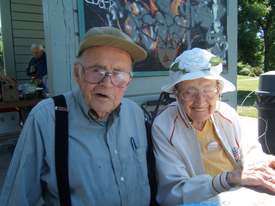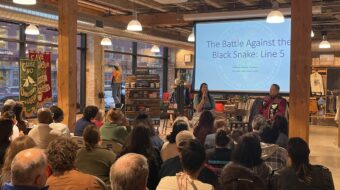
Celebrating 75th anniversary of Civilian Conservation Corps points to job, education possibilities for today
DECEPTION PASS STATE PARK, Wash. — The Civilian Conservation Corps (CCC) put millions of jobless youth to work planting trees, fighting forest fires, building parks, roads and trails during the Great Depression. CCC alumni are now observing the 75th anniversary of the program founded by President Franklin Delano Roosevelt. Many say the CCC should be brought back to provide jobs and educational opportunities for millions of unemployed youth today.
Roosevelt signed the bill creating the program 17 days after taking office in 1933. Within a month 300,000 jobless young men had enrolled. By the time the CCC was terminated in 1942 over three million men between the ages of 17 and 23 had served. They were housed in hundreds of CCC camps across the nation. It included 250,000 African American men.
Some of the camps were integrated but racists demanded segregation and in 1935, Black enrollees were housed in 150 all-Black camps. The NAACP and other anti-racist groups protested this racist discrimination.
The young workers were assigned to a multitude of tasks mostly in the forests of the west. The U.S. Army requisitioned trains that brought hundreds of thousands of CCC enrollees west. The CCC workers planted two billion trees on land decimated by timber company clear-cutting. The CCC earned the nickname “Roosevelt’s Tree Army.”
They also fought forest fires, erected thousands of fire lookout towers, built thousands of miles of roads and bridges and helped in soil conservation and reclamation. The CCC workers cleared hiking trails and built state parks like the dramatic Deception Pass State Park on Whidbey Island, still enjoyed by thousands of campers, picnickers, and sightseers today.
The park here hosts a CCC Interpretive Center established by CCC Alumni Chapter 78 in Everett, Washington. The centerpiece is a heroic bronze statue of a bare-chested youth, “The CCC Worker.” An exhibit of photos, tools, mess kit, uniform, documents and other memorabilia of the CCC is in a stone and timber bathhouse built by CCC workers. It features a video titled “The Best Time of My Life” in which CCC alumni recount the profound influence the CCC exerted on their lives.
Visitors are invited to write their comments in a log book as they leave the center. “Let’s bring back the CCC,” wrote a couple from Seabeck, Wash. It is one of many entries with that same message.
Duane Fuehr of Centralia, Wash., volunteer host at the park, told this reporter that both his father and uncle were CCC workers. His father was a skilled logger and was placed in charge of a CCC crew at a camp near Centralia, he said.
“It would be good to bring back the CCC,” Fuehr told the World. “Some of the young people who graduate from high school are going on to college. Others will join the military like I did. But a lot of these kids don’t know what they are going to do with their lives. It would be good for them to give a year for the country.”
A spokesman for the CCC Alumni Association in St. Louis, MO. confirmed that “a lot of the alumni feel that way. They know what the CCC did for them. Many learned the trade that carried them through the the rest of their lives in the CCC. It definitely worked back then. A lot of people have contacted Congress urging that the CCC be reestablished. But the lawmakers have rejected the idea.”
Many local chapters of the CCC Alumni Association have already held events celebrating the 75th Anniversary and more celebrations will take place at the association’s annual convention Sept. 25-28 at Prince William Forest Park where Camp Roosevelt, the first CCC camp was established in 1933. The convention will recess and visit the Franklin Delano Roosevelt memorial in Washington, D.C.
The Interpretive Center records the memories of many of the CCC workers. “Food for the many hungry men was measured by the train-load,” reads the explanatory text on one exhibit. One enrollee, Ed Devine, wrote, “Half of what we ate came from nearby suppliers. These large purchases helped the local economy. Plentiful food helped the young enrollees too. I went from 128 pounds up to 155 in nothing flat and none of it was fat.”
John Tursi writes, “We came from very poverty-ridden circumstances. For many, many days, maybe a little bowl of soup a day would be it. We just didn’t eat. But the food out here was just fantastic. To wake up and go into all the hotcakes you could eat and all the butter you wanted and milk and eggs!”
An estimated 50 percent of CCC enrollees were high school dropouts, and an estimated three percent were illiterate. The CCC established an educational program, providing classes in a wide range of academic subjects as well as vocational training. Some even learned to read and write in the CCC or earned their high school diplomas.
I ran into a CCC veteran, Jim Cassidy of Puyallup, Wash., at a PWW picnic in Seattle. He told me he joined the CCC in 1933 in Bucoda, a tiny sawmill town in Thurston, County, Washington. “My dad hadn’t worked for two years,” Cassidy explained. “CCC workers were paid $30 a month. Five dollars was pocket money for us, the rest was sent home. When my $25 a month started coming home, it was a lifeline for the family.”
He was sent to Leavenworth, Washington, a town on the eastern slopes of the Cascade Mountains, he said. His first job was helping build a road up the Icicle River to Lake Wenatchee. It is still in use today.
“That meant cutting down some trees,” Cassidy said. “In some stretches, we had to blast our way through solid granite. The road was for fire protection. During the same year, there was a big forest fire over in Skykomish on the Beckler River. We went over there and put it out.”
Being a CCC worker was not the only benefit Cassidy won from Roosevelt’s New Deal. The Wagner Act was passed and signed by Roosevelt recognizing workers’ right to join a union, bargain collectively, and go on strike to win higher wages and benefits.
“I had heard my dad talking about the Wobblies (The Industrial Workers of the World) and their idea of ‘One Big Union.’ My dad would go to union meetings. We were trying to organize the loggers and sawmill workers. It started out as the Carpenters & Joiners but they were like all the other craft unions. So we started to organize the Congress of Industrial Organizations and the International Woodworkers of America, one union for all the mill workers and loggers.”
Cassidy said the nation needs a program like the CCC, today, to provide jobs and training for millions of jobless youth. “We need the camps but we don’t need the military to run it,” he said. “They put military officers in charge.” The result was strict military discipline. The CCC workers were awakened by a bugle playing reveille in the morning and went to sleep with taps at night. There were regular military-style inspections of the barracks.
But a program that restores the CCC with an accent on “civilian,” that abolishes the CCC’s racially segregated camps, and opens it, this time, to young women as well as men, is an idea that should be “high on the agenda” of a new administration in Washington, Cassidy said.
Back in 1996, James C. Ronning, then president of the National Association of CCC Alumni, pledged to fight to “bring back the CCC.” He called the CCC “the greatest national youth program ever seen in the United States” arguing that the CCC’s goals are still as urgent as ever. “The final one, to bring together people from all backgrounds teaches people to tolerate, and even appreciate, each other and work together in a spirit of cooperation,” he wrote. “This is one goal that, if anything, seems even more relevant as we face new divisiveness in our country today.”










